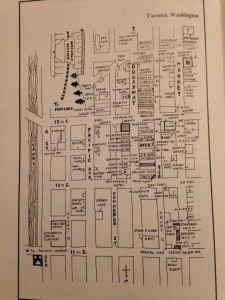Tacoma Japantown Walking Tour Case Study
Backendless-powered self-guided app for Japantown of Tacoma
INTRODUCTION
Using Backendless as a primary platform, a Backendless user named Josh created the Tacoma Japantown Walking Tour app, which can be accessed from the Google Play Store and the Apple App Store. Built to facilitate visits to the historic Nihonmachi (Japantown) of Tacoma, WA, this app offers practical, and creative help. Maps indicate major points of interest for tourists with both historic and modern images to add value to every location. Essay links that have been compiled by noted historian Michael Sullivan and writer Tamiko Nimura provide additional historical information for visitors.
CHALLENGE
 Josh had been searching for a product that would offer a flexible backend with intelligent push notifications support for his projects. Using an awkward process of taking images and loading these onto Josh’s iPad Pro, Michael and Tamiko shared these with visitors when guiding them around the site. After several tours using this method, Josh decided to find a solution by creating an app where visitors could access images for themselves. After the app grew in popularity they realized that the tour could be self-guided, leading to the creation of current, comprehensive changes to the app.
Josh had been searching for a product that would offer a flexible backend with intelligent push notifications support for his projects. Using an awkward process of taking images and loading these onto Josh’s iPad Pro, Michael and Tamiko shared these with visitors when guiding them around the site. After several tours using this method, Josh decided to find a solution by creating an app where visitors could access images for themselves. After the app grew in popularity they realized that the tour could be self-guided, leading to the creation of current, comprehensive changes to the app.
Prior to discovering Backendless, Josh had used up a lot of unnecessary time with other backend developers to create APIs and suitable data backends. This method proved to be time-consuming with the boilerplate code requiring repeated refinements.
SOLUTION
Backendless does away with all the hard slog involved in this type of project. Our platform encompasses a flexible database and APIs while providing extensive storage for data since the product incorporates a scalable cloud-based solution. All of this means that developers can concentrate on the integration of front-end data interaction. These features are predominantly useful when cooperating with groups who have limited resources. ‘Backendless further includes a sandbox as a flexible deployable solution when the product is ready to be tested,’ – says Joshua.
The technology stack supporting this app consists of Backendless, Swift (iOS), Java (Android) and WordPress. The functional set on which this app is based includes :
- Backendless, which controls location data such as latitude and longitude, descriptive text and links to image files on the Backendless data service.
- polls a WordPress site for new posts to ingest and send out push notifications
Swift (iOS), Java (Android), with native iOS and Android applications to display location, and a map with interest points, location, and a news/event feed. - WordPress, that allows for news and event posting. WP’s API is used in Backendless, which also provides for posts to the Facebook group and Twitter.
The Backendless program continuously checks for new data and updates all new posts via the WordPress API. Immediately new posts are detected, the post data is retrieved by Backendless, triggering a notification for transfer of new information. Once the application begins, new posts will be queried through Backendless, which then feature in the Japantown app.
Josh was excited by the convenience offered by Backendless, saying ‘push notifications that are managed through Backendless are really helpful for our tours.  Other apps just don’t give us what we need without needing substantial changes, but I still need to build a function into the app that will allow Michael and Tamiko to add their own images for new signs and boundaries to add interesting facts about Japantown. That is just one thing that currently needs to be changed. Understanding of Tacoma’s vibrant Japanese-American history gives me a stronger sense of the cultural value of this service. Even the brief messages announcing that, “You’ve arrived” drive my passion to create new memories for visitors to remind them of their time spent at Japantown.’
Other apps just don’t give us what we need without needing substantial changes, but I still need to build a function into the app that will allow Michael and Tamiko to add their own images for new signs and boundaries to add interesting facts about Japantown. That is just one thing that currently needs to be changed. Understanding of Tacoma’s vibrant Japanese-American history gives me a stronger sense of the cultural value of this service. Even the brief messages announcing that, “You’ve arrived” drive my passion to create new memories for visitors to remind them of their time spent at Japantown.’
‘These have been just some of the convenient benefits I experienced with Backendless after a long search for the perfect match to my needs, and those of my customers.’
RESULTS
- Over 3000 downloads in the App Store and Play Market, and growing daily.
- The app code is flexible and can be duplicated for reuse in other projects with minimal changes needed.
- Automatic built-in scalability to store more and more data is just one more feature that ensures the app remains current.
Josh shared more of his Backendless experiences with us. You can also read more about the app in our Backendless Spotlight article from 2019.
Do you have any ideas for your new projects? Are you planning to build them with Backendless?
Yes! I am currently working with several small businesses, which need private communications with their clients. Most of these are managed by women and minority groups run by women. We are collaborating to find optimal tech solutions to boost these likeminded businesses. Start-ups and small businesses don’t have access to resources which will enable them to acquire native mobile applications, so a product such as Backendless really offers a great way to create tailor-made solutions for these entrepreneurs, which is backed by reliable backend support for their data and notifications. Backendless further affords great options in terms of numerous way to create extensible native mobile templates.
What is your source of inspiration and what motivates you to be a volunteer, basically supporting such projects all by yourself?
I was an educator and artist before I discovered my interest in development projects, when I also began to make extensive contributions to open-source projects. After making this move I specifically wanted to focus on supporting the arts and education with my new knowledge. Because these are fields were funding is notoriously scarce, I believed this was where I could create the most value. One example that comes to mind is a music teaching studio that needed to communicate with its students without Facebook or Slack, so using Backendless was the ideal answer to their challenge. Development projects are frequently out of the reach of new businesses, which makes supporting them with Backendless a valuable, affordable way to augment their business offerings.
How much time do you spend on such kind of projects?
Time spent depends on customer requirements, but usually averages out at about 10 hours a week. Remember that this is in addition to other projects, all of which may be at different stages of development. Also, it takes time to plan for the ideal outcome that clients and myself have in mind.
